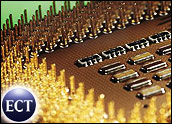
A partnership between Texas Instruments and the Massachusetts Institute of Technology has produced a proof-of-concept microchip architecture that is 10 times more efficient than current technologies.
The design — which was presented on Tuesday at the International Solid State Circuits Conference — uses a redesigned memory and logic architecture to allow the chip to operate at a much lower voltage level, which allows devices such as cell phones to operate with a longer battery life.
While consumers likely won’t see any new devices for at least five years, researchers say the chip could help build long-lasting cell phones and implantable medical devices that use body heat to power its systems. The research, funded in part by the U.S. Defense Advanced Research Projects Agency (DARPA), could also lead to the development of military sensor networks that are scattered across the battlefield.
“These design techniques show great potential for TI future low-power IC (integrated circuit) products and applications including wireless terminals, RFID, battery-operated instrumentation, sensor networks, medical electronics and many others,” said Dennis Buss, chief scientist at Texas Instruments.
How the Chip Was Done
The chip’s development required the researchers to re-imagine how the circuits on the microchip were powered.
That was no simple task considering that microchip architecture was designed to work at one volt, while the new chip is powered at 0.3 volts. To accomplish that, the designers built a DC-to-DC converter directly on the chip, then integrated the memory and logic systems with the converter.
The end result will be a more efficiently powered microchip, which — if the design can be cheaply manufactured — leapfrogs several generations of innovation, said Gideon Intrater, vice president of solutions architecture for Mountain View, Calif.-based MIPS Technologies, a semiconductor design firm.
“In the past, with each transition from one process generation to the next, power consumption was reduced by a factor of about three times,” Intrater told TechNewsWorld. “These process transitions occurred roughly every two to three years.”
Coming Soon
The new microchip is still in the design phase, so it’s difficult to predict the types of devices that might hit the market in the near future; however, the chip would have the capability of extending the current battery life of devices already on the market.
The increased power, though, would also likely lead to smaller — and more powerful — devices that could run longer and more efficiently between charges.
“It is clear that any battery-operated device could benefit from the longer battery life and smaller battery size,” Intrater said. “These products could include traditional mobile consumer devices like cell phones, PDAs and media players, as well as medical devices.”




















































